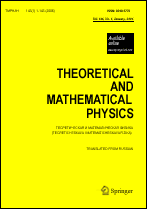|
This article is cited in 1 scientific paper (total in 1 paper)
Form factors in the $\mathcal{N}=4$ maximally supersymmetric Yang–Mills theory, soft theorems, and integrability
L. V. Borkab, A. I. Onischenkocd
a Institute for Theoretical and Experimental Physics, Moscow,
Russia
b The Center for Fundamental and Applied Research, Dukhov All-Russia Research Institute of Automatics, Moscow, Russia
c Moscow Institute of Physics and Technology (State
University), Dolgoprudny, Moscow Oblast, Russia
d Skobeltsyn Institute of
Nuclear Physics, Lomonosov Moscow State University, Moscow, Russia
Abstract:
We discuss the universal soft behavior of form factors in the $\mathcal N=4$ maximally supersymmetric Yang–Mills theory in the limit where the momentum of one of the particles tends to zero. We present details of how the tree-level form factors of this theory are related to eigenfunctions of a $\mathfrak{gl}(4|4)$ integrable spin chain.
Keywords:
$\mathcal N=4$ supersymmetric Yang–Mills theory, amplitude, form factor, integrability, soft theorem.
Received: 15.12.2015
Revised: 01.03.2016
Citation:
L. V. Bork, A. I. Onischenko, “Form factors in the $\mathcal{N}=4$ maximally supersymmetric Yang–Mills theory, soft theorems, and integrability”, TMF, 190:3 (2017), 391–402; Theoret. and Math. Phys., 190:3 (2017), 335–344
Linking options:
https://www.mathnet.ru/eng/tmf9126https://doi.org/10.4213/tmf9126 https://www.mathnet.ru/eng/tmf/v190/i3/p391
|


| Statistics & downloads: |
| Abstract page: | 285 | | Full-text PDF : | 106 | | References: | 43 | | First page: | 18 |
|



 Contact us:
Contact us: Terms of Use
Terms of Use
 Registration to the website
Registration to the website Logotypes
Logotypes